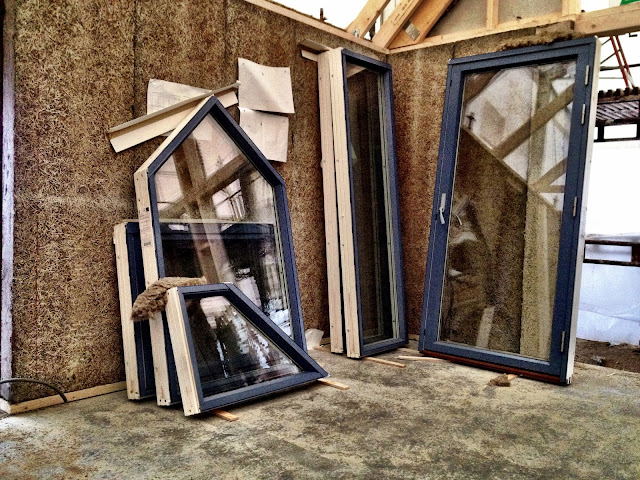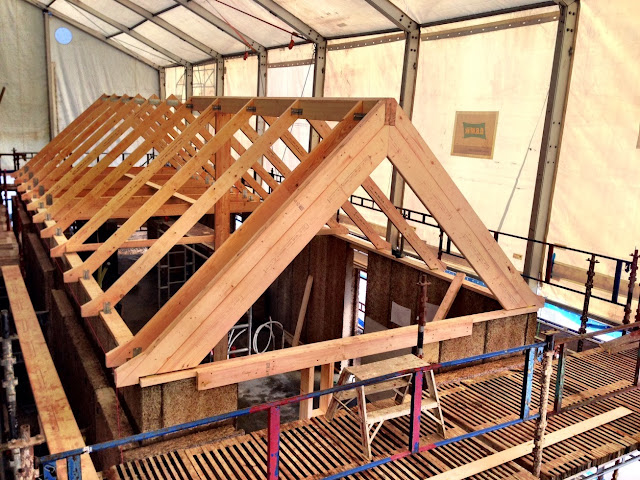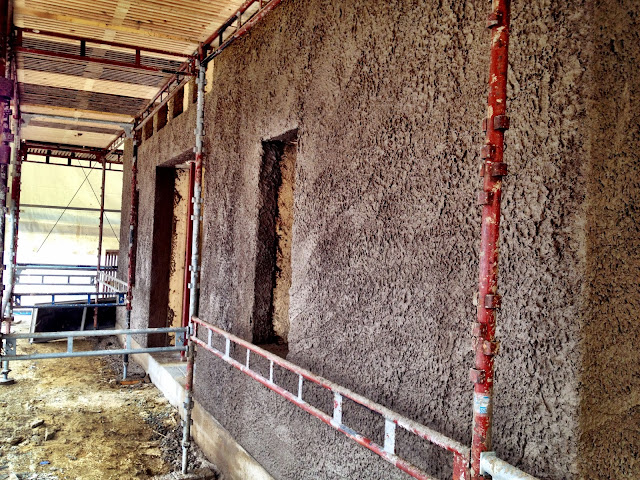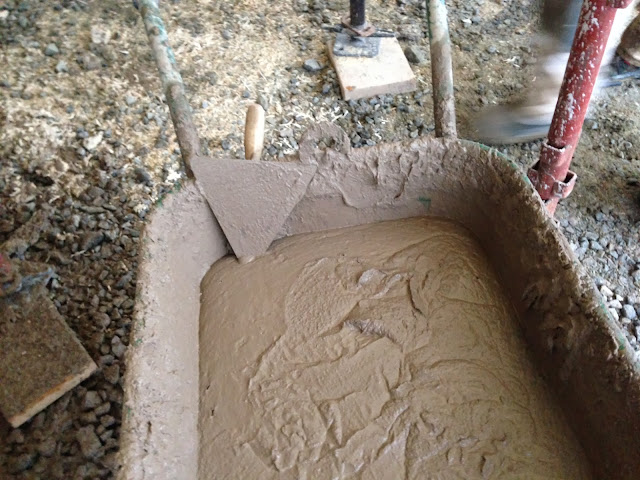We have chosen to build a house that is vapor permeable. That means that the house can breathe. It should be air tight, but moisture should not be trapped in the structure.
Undantaget är grunden där vi valde foamglas som är diffusionstätt för att vi inte vill att markfukten ska vandra in i huset. Väggar och tak ska däremot kunna andas. Väggarna är byggda av träullit, ett material som kan andas. På både insida och utsida finns det puts som gör väggen vindtät men låter fukt vandra in och torka ut. På insidan av taket och gavlarna ska vi sätta en så kallad ångbroms. Det är en duk som släpper igenom ånga men som stoppar varm luft från att gå in i takisoleringen där den skulle kylas av och kondenseras.
The exception is the foundation where we chose foamglas which is vapor-tight, since we don't want to let the mositure from the ground into the floor. Walls and ceiling should be able to breathe, though. The walls are made of träullit, a material that can breathe. On the inside and outside of the walls there is plaster/stucco which makes the walls air tight but lets moisture in and, more importantly, out. In the ceiling we will put a vapor permeable air barrier membrane. It lets vapor through but stops warm air from going into the insulation in the roof where it would be cooled off and condense.
 |
| Källa: http://nwp-temp.se/_mataki/wp-content/uploads/Produktbroschyr5.pdf |
En ångbroms är
tätare än ett vindskydd som man sätter utanpå takisoleringen, men mindre tät än
en ångspärr eller fuktspärr. Tumregeln är att man väljer ett material till
insidan av väggen som är 5 gånger tätare än utsidan av väggen. För
takkonstruktioner ska förhållandet vara 1:10.
Väljer man en plastfolie på insidan kan det bli mycket tätt. Det är ju
bra att ha det tätt men om det skulle bli en spricka i tätskiktet eller om det
finns byggfukt inne i konstruktionen har den ingen möjlighet att torka ut. Vi
tycker det känns säkrare att bygga på ett sätt som låter konstruktionen andas
ut den fukt som av någon anledning trängt sig in.
A rule of thumb prescribes a vapor barrier on the inside of the wall that is about 5 times as tight as the outside of the wall. The same ratio is 1:10 for the roof structure. If you build with a tight plastic membrane instead, it could be too tight. Tight is good but if there are cracks in the membrane or if there is moisture in the structure from the construction period it won't be able to dry. It feels safer to have a structure that can breathe and let the moisture that somehow made its way in there dry out.
 |
| Källa : http://nwp-temp.se/_mataki/wp-content/uploads/Produktbroschyr5.pdf |
Ett exempel på
vad som kan hända om fukt blir instängd bakom plast är våra tegelpannor. Vi
köpte begagnat taktegel i våras och lät de ligga kvar på lastpallarna hela
sommaren och hösten. När de lyftes med kranbil hade vi satt på plast runt
pallarnas sidor för att hålla pannorna på plats. Vi tog inte av plasten direkt
utan väntade nästan ett halvår. Tegel kan inte mögla men den smuts och mossa
som finns på tegel kan mögla. Regnvattnet som föll på teglet kunde inte torka
ut på grund av plasten. Därför började det växa mögel på en del av pannorna. Lätt
att fixa eftersom själva pannorna inte möglat eller förstörts men det visar
verkligen vad som kan hända om man stänger in fukt på fel sida om platsen. Nu står våra tvättade takpannor upp, utan plast, så vinden kan torka bort regnet!
One example of trapping moisture behind a plastic film is our roof tiles. In the spring we bought used clay roof tiles. Before the crane moved them we wrapped the pallets in plastic to keep them stable. We did not remove the plastic for almost 6 months. Clay tiles don't mold but the dirt and moss that were on them certainly can. The rain water that fell could not dry because of the plastic. Therefore, we had mold growing on some of the tiles. Easy to fix since the clay tiles don't mold or rot but it clearly illustrates what can happen if moisture ends up on the wrong side of the plastic. Our cleaned tiles are now standing up, without plastic, so the wind can dry them!
Läste noggrant
anvisningarna för den ångbroms vi tänkte använda och insåg att den inte var
alkalibeständig...med träullit väggar och puts så blir det högt pH-värde och därför är detta ingen bra produkt för oss. Letar nu vidare efter en ångbroms som passar vår
konstruktion, och har hittat variabla ångbromsar - ångmotståndet varierar beroende på
luftfuktigheten. När det är torr luft, som det är på vintern, blir ångbromsen tätare och
släpper ut mindre fukt i takisoleringen. Men på sommaren när det är fuktigare
luft inomhus blir den mer genomsläpplig, och fukt som finns i isoleringen kan
torka inåt i huset och ventileras bort.
When I carefully read the instructions for the vapor membrane I was planning on buying I realized that it could not handle an environment with high pH...with träullit walls and stucco/plaster you get a high pH so this was not the right product for us. I am now searching for an alternative product and have come across vapor membranes that have variable permability - the permability varies with the humidity. When the humidity is low, in the winter, the membrane is very tight and does not let vapor into the roof insulation. But in the summer when the humidity is higher, the membrane becomes more permeable and lets moisture from the roof structure dry into the home and from there it is ventilated away.

















